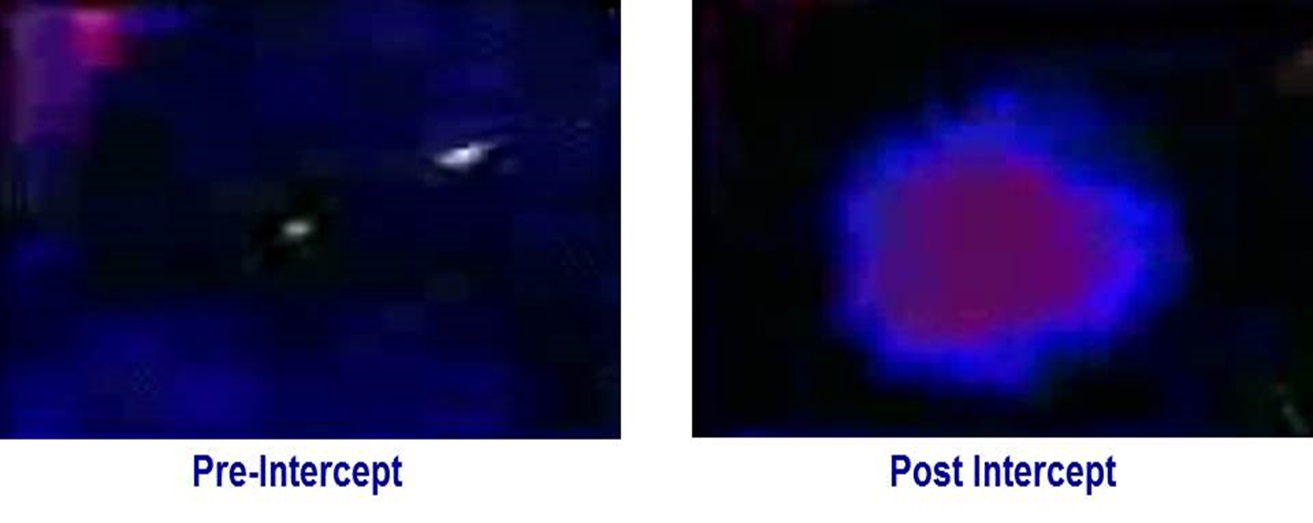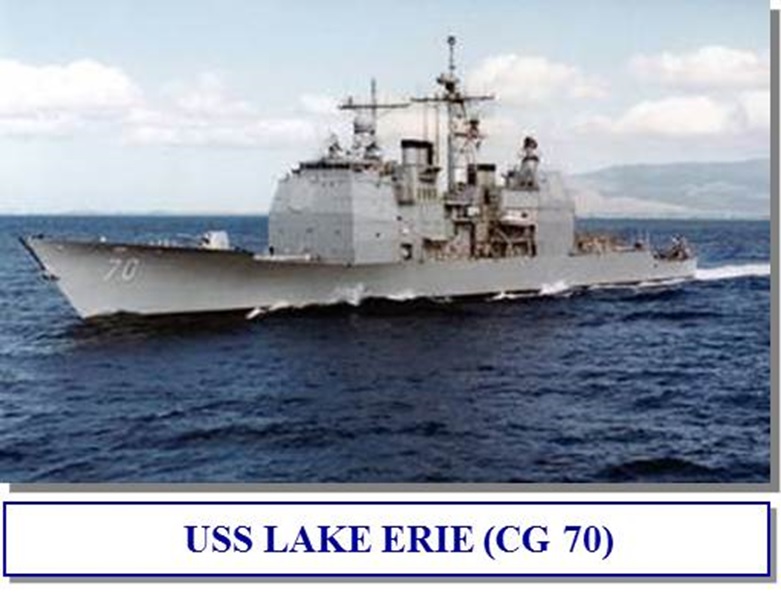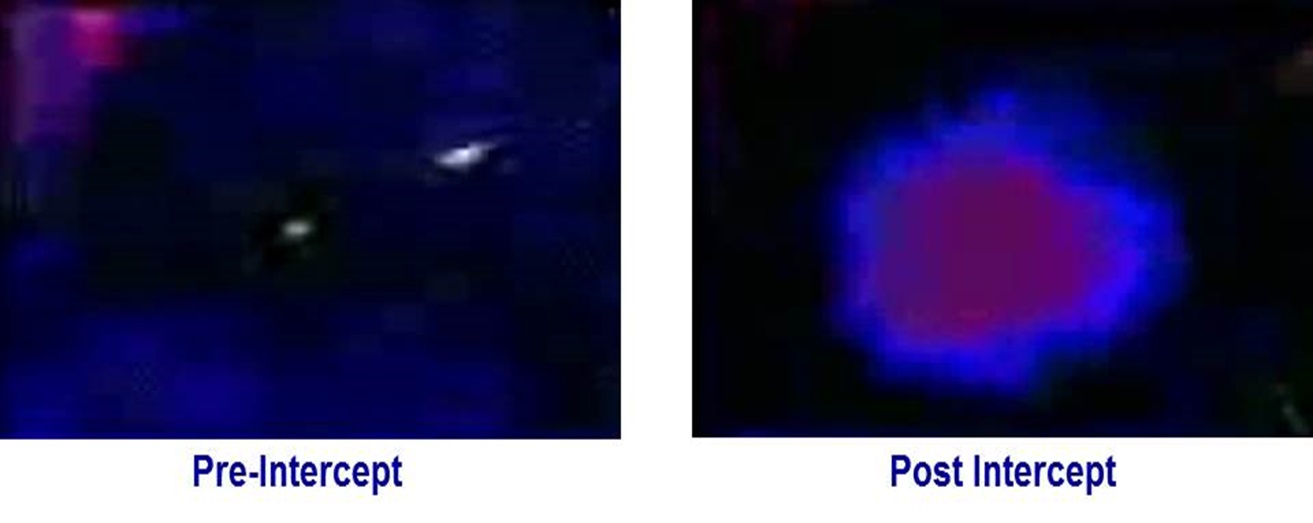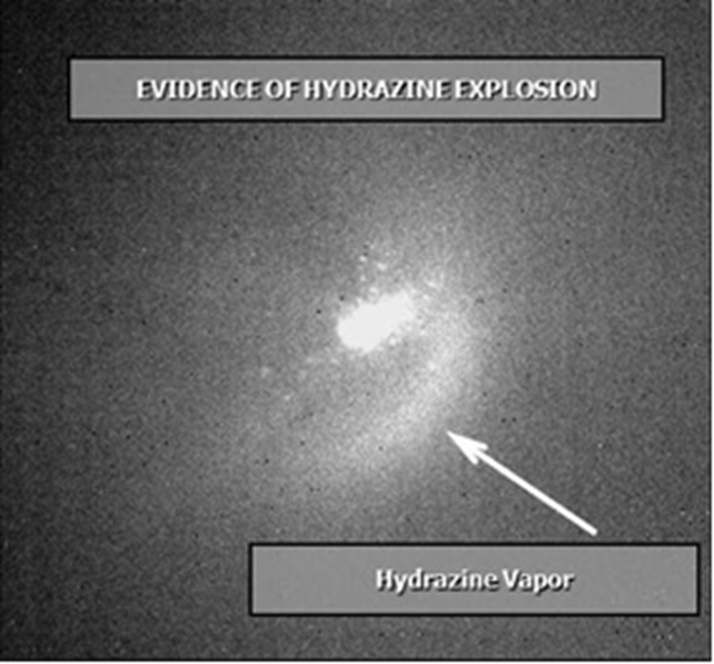
Dahlgren’s Joint Government/National Laboratory/Industry Team
Makes History in Satellite Shootdown
By John Antonelli,
Aegis BMD
Who would have imagined that a small military base, originally recognized for its accomplishments in naval gunnery, would be the location of the ballistic missile defense program where government, national laboratories, industry engineers, and shipboard trainers were directly responsible for the successful satellite shootdown in 2008? With only the experience of intercepting ballistic missile targets in space, the challenges presented to the Dahlgren government/national laboratory/industry team were numerous and substantial.
The satellite was a higher and faster target than the ballistic missile targets engaged in previous flight tests. The satellite’s orbit was decaying, allowing a limited amount of time to plan, analyze, develop, test, install shipboard modifications, train ships’ crews, and execute a mission never before attempted. Safeguarding human life against an uncontrolled reentry of a satellite containing hazardous hydrazine propellant was the objective. The following is an account of the Dahlgren team’s significant contribution to national history.
Decision Made
When President George W. Bush was informed that an American, non-operational reconnaissance satellite had begun to fall from its orbit, he became concerned about the hazardous hydrazine propellant tank that would survive reentry and cause personal harm if it impacted in a populated area. He tasked the U.S. Strategic Command (USSTRATCOM) to determine a course of action. After reviewing all options, USSTRATCOM decided to intercept the satellite in space with a missile developed for ballistic missile defense and destroy the hydrazine tank. USSTRATCOM had overall command of the intercept. Terrestrial and space sensors, under the command of the Space and Missile Defense Command and the Joint Space Operation Center, respectively, tracked the satellite and provided such data to the Missile Defense Agency (MDA). The agency used Ballistic Missile Defense System sensors and communication architecture to track the satellite and transmit track data to Navy ships. The MDA also directed the Aegis Ballistic Missile Defense (BMD) Program to make the necessary system modifications to detect, track, engage, and destroy the satellite prior to reentering Earth’s atmosphere. The mission’s objective was to intercept the satellite, reduce the mass that might survive reentry, vector that mass into an unpopulated area (ideally the ocean), breach the hydrazine tank to vent the toxic fuel, and let the debris and hydrazine burn-up during reentry. Aegis BMD, a military tenant command at Dahlgren, and the Navy were assigned significant roles in this mission.
The Planning Phase
Aegis BMD led the joint team that developed the system modifications required to intercept the satellite, and coordinated with the Navy for ship availability, modification installation, and training ships’ crews. The intercept of a satellite had never been done before, and many challenges were presented to this team. Comparing the satellite to a ballistic missile, the trajectories are different. A satellite is in orbit and the ballistic missile flies a ballistic trajectory. The satellite was a higher and faster target than the ballistic missile targets Aegis BMD had intercepted in previous flight tests. A successful intercept required longer radar and missile seeker detection ranges, extended missile flight time, and greater guidance accuracy, given the higher closing velocities. There was concern whether the Standard Missile (SM)-3 could hit the hydrazine tank.
The satellite was also a cold target. The satellite had been traveling through frigid space for several years, rendering it much colder than a ballistic missile. The SM-3s use an infrared seeker to detect heat and guide it to its target. The Aegis BMD system also contains defaults to prevent engaging friendly tracks. Would the Aegis BMD system contain enough margins to be modified and fulfill these requirements? And could these modifications be made, analyzed, and installed before the satellite entered Earth’s atmosphere?
“This was uncharted territory. The technical degree of difficulty was significant here.”
General James E. Cartwright, USMC, Vice Chairman of the Joint Chiefs of Staff
February 21, 2008
Once the order was given, numerous ships and shore-based sites tracked the satellite, providing daily updates of real empirical data to the John Hopkins University Applied Physics Laboratory (JHU APL), Lockheed Martin Maritime Systems and Sensors, and Raytheon Missile Systems. This kicked off an intense study to determine intercept feasibility. The empirical data was used to characterize the satellite and to improve Aegis BMD models and analysis, thus commencing tens of thousands risk reduction analysis runs.
As the Technical Direction Agent for the Aegis BMD Program, JHU APL led the performance analysis efforts. To fully understand how the weapon system would perform against the satellite, JHU APL worked closely with the design agents, Lockheed Martin and Raytheon, to assess the existing system capability and identify the necessary weapon system modifications to successfully accomplish the mission. To do this effectively and in a realistic fashion, JHU APL provided the engineering community with a complete characterization model of the satellite. The observed satellite track data was used to anchor this new model. This target characterization and the resulting performance analysis allowed JHU APL to define the launch window; determining optimal engagement locations, ship positions, and the time of day to engage. Ultimately, the fire control loop began at JHU APL, where daily updates of the satellite location coordinates were received from the Joint Space Operation Center and processed into a coordinate frame used by the ship. The data was then transmitted to a number of organizations participating in the engagement.
Much of the Aegis BMD Weapon System work was performed at the Aegis Combat System Engineering Development Site (CSEDS) in Moorestown, New Jersey. CSEDS is the Aegis BMD Weapon System land-based test site where shipboard configurations of equipment and computer programs are located. Lockheed Martin engineers developed test programs and rewrote hundreds of lines of computer program code. These test programs were taken to CSEDS where engineers and sailors worked together to check out the changes. Their real-time collaboration with the land-based Aegis BMD Weapon System was a critical factor in meeting the mission timeline. Upon successful checkout, modified tactical programs were delivered and installed in three ships.
In Tucson, Arizona, Raytheon engineers worked on SM-3 modifications. They conducted extensive modeling and simulation efforts to evaluate engagement and intercept performance of proposed changes. Such efforts were coordinated with JHU APL and Lockheed Martin to analyze system performance. The SM-3s were modified and delivered to the ships.
Using the established Aegis training infrastructure, the Aegis Training and Readiness Center, another command located at Dahlgren, developed a syllabus to train the crews on each ship. The best ship trainers were selected, formed into training teams, and sent to the ships.

The Execution Phase
The Navy made three Aegis BMD ships available for this mission: USS Lake Erie (CG 70), USS Decatur (DDG 73), and USS Russell (DDG 59). The modified tactical computer programs were installed, the modified missiles were loaded, and training commenced once the ships were at sea. Extensive crew training was conducted. The ships’ crews tirelessly rehearsed receiving track data from land and space sensors, searching ownships’ radar, detecting and tracking the satellite, and simulating engagements. Afterward, on-board engineers analyzed the data to ensure the modified computer programs were working correctly.
The intercept would be close to Earth’s atmosphere to allow the majority of the debris to burn up upon reentering the atmosphere. The lower the intercept occurred, the quicker the debris would burn up. The SM-3 would be launched using remote track data from remote sensors. A short time later, the shipboard AN/SPY-1 radar would detect and track the satellite and transmit guidance commands to the missile.
The window to fire the missile was dictated by the decaying orbit of the satellite. After being briefed on the status of the mission on February 20, 2008, Secretary of Defense Robert Gates approved the launch. CG 70’s Aegis BMD Weapon System had been in continuous receipt of satellite tracking data from remote sensors, calculating instantaneous fire control solutions. At approximately 10:26 p.m. EST, CG 70 fired the modified SM-3. Immediately, the SPY-1 radar acquired and tracked the missile. Radar search sectors were generated, and when the radar detected the satellite, the weapon system calculated a fire control solution based on ownship’s track data and uplinked guidance commands to the missile. The missile intercepted the satellite. The Joint Space Operation Center in Vandenberg, California, confirmed the satellite’s breakup.

Analysis from space and land-based sensors categorized the vast majority of debris as small. Post-intercept analysis revealed that most of the debris burned up upon reentry as predicted. A fireball was visible and, given the satellite was never operational, this indicated a hydrazine fire. The fireball was followed by a vapor cloud, further evidence of hydrazine release. Finally, spectral analysis from airborne platforms also indicated trace presence of hydrazine. Based on such analysis, officials were confident the hydrazine tank had been ruptured. Mission accomplished!

The Aegis BMD Weapon System and the Standard Missile possessed the performance margins to successfully accomplish this mission. As stated by RADM Joseph Horn, Deputy Director Surface Warfare for Combat Systems/Weapons, “The fact we were able to take a system designed for one thing and exercise it in a different way speaks to the performance margin and also provides us a tremendous degree of confidence that the engineering is sound, our training is satisfactory and our people are ready.”
The performance of the joint team led by Aegis BMD and the Navy was nothing short of extraordinary. Because the intent was to safeguard human life, everyone associated with the mission showed remarkable professionalism and limitless determination. The superb ability to plan, engineer, and successfully execute a mission that had never before been attempted, and in such a short amount of time, is testimony of the significance of this total team effort.
“Had we not had the infrastructure and the processes that Aegis was built on; had we not had the team at Lockheed Martin; had we not had CSEDS and the Sailors and people there; had we not had the analysts at APL, Dahlgren and the engineers at Raytheon; had we not had ATRC and the ability to pull together a training package; had we not had that infrastructure, it would not have been possible.”
RADM Alan Hicks, Aegis BMD Program Director
Over the next several weeks, the ships’ weapon systems were returned to their normal configurations, the unfired missiles were sent to the factory for “de-modification,” and the attention of the world shifted elsewhere. Aegis BMD’s one-time mission to destroy a dead but dangerous satellite had been successfully accomplished under a punishing timeline and in extraordinarily novel fashion, and it had executed so flawlessly and in an almost unnervingly routine manner. This event evidenced that Aegis BMD earned the right to say “At Sea, On Station, Ready for Call for Fire.”
The satellite shootdown is only one of Dahlgren’s many historic accomplishments. There are more! Recent and past Dahlgren history is filled with such astonishing events you can learn more about as Dahlgren celebrates its 100th anniversary commencing. You are invited to view the Dahlgren Heritage Museum website at www.dahlgrenmuseum.org to learn more about the base and its accomplishments.